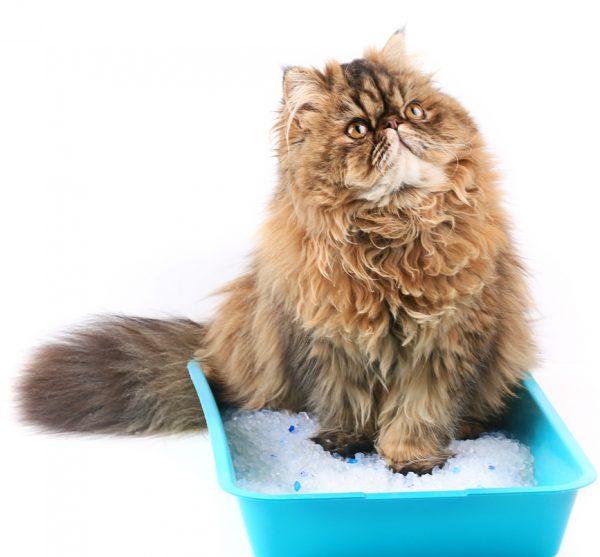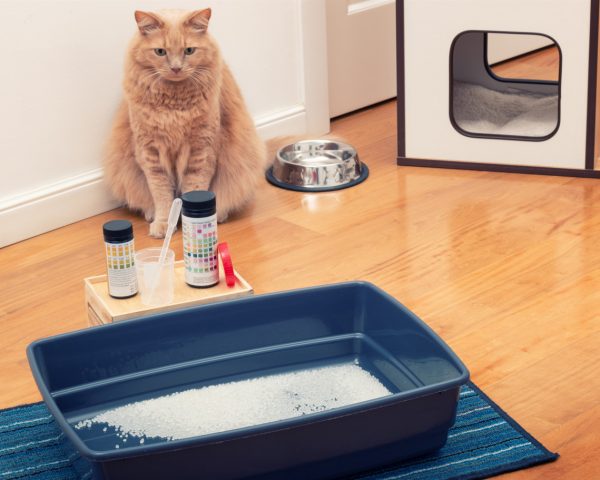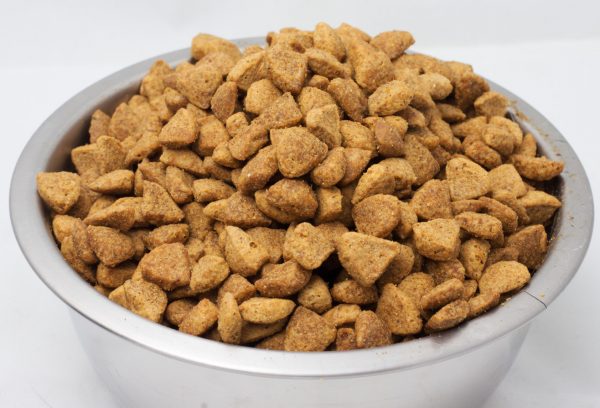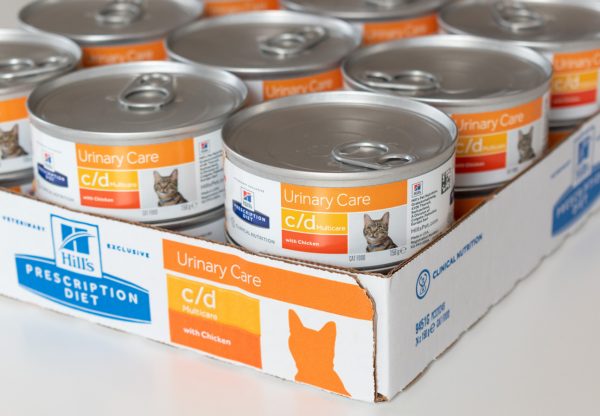Feline UTIs
A urinary tract infection in cats is uncommon but is often an indicator of Feline Lower Urinary Tract Disease (FLUTD). Most cat urinary tract infections occur in felines aged 10 or older who also suffer from endocrine diseases such as hyperthyroidism or diabetes.
A urinary tract infection in cats occurs when bacteria travel up the urethra and into the bladder. Once in the bladder, the bacteria reproduce—causing the UTI. A UTI sometimes results in bladder stones.
This article discusses feline UTIs and also provides information on FLUTD. FLUTD encompasses a variety of diseases associated with the lower urinary tract.
Diagnosing Urinary Tract Infections
Feline UTIs are diagnosed with a urinalysis, which involves taking a sample of the cat’s urine and measuring the amount of red and white blood cells, bacteria, crystal, protein, bilirubin, glucose, and ketones. A urinalysis also reveals the urine’s pH levels and concentration.
A culture and sensitivity test may also be performed. With this test, the bacteria found in the urine is grown in a laboratory so it can be identified. The most common bacteria causing a urinary tract infection in cats is Escherichia coli—the bacteria found in feces. Once the specific bacteria causing the UTI is identified, the vet can prescribe the appropriate antibiotic.

Cat Urinary Tract Infection Symptoms
The most common feline UTI symptoms are:
- Frequent attempts to urinate but with decreased amounts of urine
- Straining to urinate
- Pain or discomfort when urinating (indicated by crying or whining)
- Reduced urination
- Urinating outside of the litterbox
- Pinkish urine (an indicator of blood in the urine)
- Licking around the rear end
Although these may be symptoms of a feline urinary tract infection, they are also common symptoms of FLUTD. Therefore, if a feline is displaying the symptoms listed above, the cat should be taken to the vet immediately. This is because some FLUTD causes—such as a urethral obstruction—can result in death within 24 to 48 hours.
Feline UTI Treatment
Cat urinary tract infection treatment typically involves antibiotics. The exact medication will be determined by the results of the urinalysis and culture and sensitivity test. Depending on the severity of the UTI, the vet may also prescribe pain medication.
Once the course of the antibiotics is complete, another urinalysis will confirm that the UTI is gone. If the infection is still present, additional diagnostic tests will be required. If a cat suffers from persistent UTIs, the vet may recommend cat food formulated for urinary tract health. (See the section on “Feline Lower Urinary Tract Disease Diet and Supplements” below.)

Feline Lower Urinary Tract Disease (FLUTD)
Feline Lower Urinary Tract Disease (FLUTD) is a catch-all term for diseases of the lower urinary tract, which includes the urethra and bladder. (The upper urinary tract includes the kidneys and ureter). Because most diseases of the lower urinary tract affect both the urethra and bladder, they are grouped together even though they may have different causes and treatments.
Feline Lower Urinary Tract Disease Treatment, Causes, and Diagnosis
FLUTD can have various causes, as outlined below. However, if the exact cause cannot be determined, the diagnosis will be Feline Idiopathic Lower Urinary Tract Disease (iFLUTD)—also called Pandora Syndrome or Feline Idiopathic Cystitis. Feline Idiopathic Cystitis accounts for 50% of FLUTD cases. Idiopathic is simply the medical term to indicate that the cause of an illness is unknown. Known causes of FLUTD include the following:
- Bacterial Infections, which can cause feline UTIs (discussed above). This occurs in 1% to 5% of FLUTD cases.
- Urinary Stones (also called “bladder stones” or “uroliths”). Occurring in 20% of FLUTD cases, urinary stones are rock-like collections of minerals that form in the urinary tract. Uroliths are diagnosed with an ultrasound, and surgery is often required to remove the stones. If the stones are classified as struvite uroliths, a special stone-dissolving diet may be prescribed before performing surgery. However, most urinary stones are made of calcium oxalate, which cannot be treated with a special diet.
- Urethral Obstruction. This happens when the cat’s urethra becomes partially or completely blocked, either by urinary stones or urethral plugs. Urethral obstructions are the cause of 20% of FLUTD cases and are almost seen exclusively in male cats. This condition is life-threatening and must be treated immediately. Left untreated, urethral obstructions can result in death within 24 to 48 hours. Treatment usually involves flushing a sterile solution through a narrow tube (catheter) placed in the urethra. Once the obstruction is removed, the cat may require antibiotics and IV therapy. If these obstructions continue, a surgery called perineal urethrostomy may be performed.
Other causes of FLUTD include birth defects, injuries to the urinary tract or spinal cord, tumors in the bladder or urinary tract, and complications caused by diabetes or hyperthyroidism. However, these causes are fairly rare.

Signs of FLUTD
The signs of FLUTD are the same as the symptoms for feline UTIs (see “Cat Urinary Tract Infection Symptoms” section above). However, because of the seriousness of some of the conditions associated with FLUTD (such as urethral obstructions), any of these symptoms—particularly the inability to urinate—necessitate an immediate visit to the vet.
Feline Lower Urinary Tract Disease Prevention
Although some cases of FLUTD will occur despite an owner’s best efforts, here are some steps to help prevent reoccurrences.
- Provide small meals more frequently.
- Make clean, fresh water available at all times. FLUTD is more common in cats that don’t drink enough.
- Make sure your cat gets enough exercise and does not become overweight.
- Talk to your vet about special diets or supplements that promote urinary tract health.
- Make sure each cat in the household has its own litterbox with the feline’s preferred litter.
- Make sure litterboxes are in quiet and private locations.
- Clean litterboxes twice a day and change the litter weekly. Frequent cleaning of the litterbox will allow owners to monitor a cat’s urination habits.
- Reduce stress and changes in routine.

Feline Lower Urinary Tract Disease Diet and Supplements
Many cat owners may ask “what is the best food for cats with urinary tract issues”? The answer to this question will depend on your cat’s specific health issues and the causes of FLUTD. Therefore, it is important to talk with a board-certified veterinarian about what food is best suited for each feline’s needs. After all, what might work for one cat might not work for another.
Most cat food companies make specially formulated dry and wet cat foods focused on feline urinary tract health. Some options recommended by your vet might include:
- Purina urinary tract cat food, including Purina One +Plus Urinary Tract Health Formula Dry Cat Food or Purina Pro Plan Urinary Tract Health Canned Cat Food
- IAMS Adult Health Urinary Tract Health Dry Cat Food
- Hill’s Prescription Diet c/d Multicare with Chicken Wet Cat Food
- Homeopet Feline UTI+ Cat Supplement



